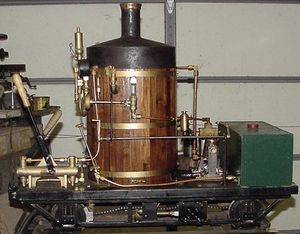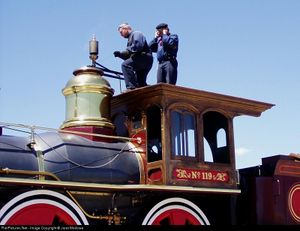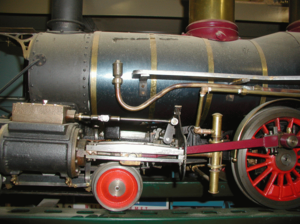Lagging: Difference between revisions
Jump to navigation
Jump to search
(→Wood) |
|||
| Line 50: | Line 50: | ||
* Jonathan Hollahan writes on live_steamer@yahoo.com: | * Jonathan Hollahan writes on live_steamer@yahoo.com: | ||
** I used two layers of 1/8". The stuff is fairly fragile, tears easily, and doesn't like masking tape. I used stainless steel wire to hold it in place until the jacket was installed. | ** I used two layers of 1/8". The stuff is fairly fragile, tears easily, and doesn't like masking tape. I used stainless steel wire to hold it in place until the jacket was installed. | ||
* [http://www.chaski.org/homemachinist/viewtopic.php?f=8&t=72960&hilit=lagging#p74152 Bill Shields writes]: | |||
** I have been using Fiberfrax for years, very happy with it. | |||
=== Felt === | === Felt === | ||
Revision as of 22:54, 31 July 2013
Lagging is a covering placed over the boiler and serves three purposes:
- Reduce heat loss from the boiler
- Provide a cooler external surface to reduce the change of burns to humans and equipment
- Provide an improved ascetic look to the boiler and locomotive
From Chaski.org:
- Question: Whats the difference between a boiler jacket and boiler lagging?
- Answer: Lagging is the boiler's insulation. The jacket is the cover for the boiler and insulation. Think of a house or other building. Where insulation has been installed on it's frame and is then covered by wood, stucco, or brick.
Insulation Necessary?
- There have been several studies done that show that cladding by itself is fairly effective in cutting down heat loss from a boiler (reported in Model Engineer at various times over the years). Insulation adds to that, but not as much as the cladding.
- When you think about it, the function of any insulation (at the temperatures in question) is to trap a layer of air and keep it from moving away from the boiler surface. The cladding by itself does that fairly effectively. Any insulation you might add should be light since its only function is to prevent air movement. A heavy, dense or tightly packed insulation would tend to transmit heat by conduction which defeats the purpose. A polished surface radiates less heat, that's why metal teapots or coffee pots are highly reflective (besides the fact that it looks nice), but painted surfaces are probably not as effective, because their colour will look quite different in the infrared heat range.
- After all, the 3 methods of heat transfer are: conduction, convection and radiation. Radiation varies as the fourth power of the Absolute temperature (Rankine or Kelvin) so at any temperatures much below a red heat, its contribution is negligible by comparison with the other two. Inside the firebox, it is the major contributor because of the radiant heat from the coal bed.
Lagging
Wool
Kaowool Cerablanket
Fiberglass
- Rich Carlstedt writes:
- Fibre Glass Matting like used on Boats or Auto repair. Not the thin stuff, but 1/8"+ thickness.
- Robert Williams writes:
- Check the McMaster-Carr online catalog]. They have several nice products for the insulation of pipes and tubing. It resembles in a very big way the products offered by the Steamfitter and may have the same origin. The nice thing is they will sell you a foot of the material or a entire roll.
Fiberfrax
- Fiberfrax
- A new material made from washed ceramic fibers with binders added to form a lightweight, flexible asbestos-free insulation. Withstands temperatures to 2300 F. Excellent for aircraft firewalls. Available in 24" wide. Sold by the foot.
- High Temp Coating
- Used as a hi temp coating over Fiberfrax, or other pourus materials. Can also be used as an adhesive to bond Fiberfrax or other pourus material together.
- Jonathan Hollahan writes on live_steamer@yahoo.com:
- I used two layers of 1/8". The stuff is fairly fragile, tears easily, and doesn't like masking tape. I used stainless steel wire to hold it in place until the jacket was installed.
- Bill Shields writes:
- I have been using Fiberfrax for years, very happy with it.
Felt
- Pat Fahey writes:
- On my 3/4" scale boilers I was using felt fabric, the cheapest that I could find, for insulation. It was easy to work with, and cut to fit around the boiler. As for the boiler jacket, yes it was stovepipe that was primed and painted.
Wood
- UnkaJesse writes:
- I insulate all of my boilers whether it visibly helps or not. I realize that 1/8 " of insulation beneath my jacketing ain't much, but common sense says it does help a teeny tiny amount. On the "Newbie Project" locomotive as featured in Live Steam magazine, I used 5/16" thick American Black Walnut both for its insulation and appearance. One can touch the walnut lagging briefly and get nary a burn, but on the locomotive boilers with 1/8", the touch must be very brief so I know it is not helping as much as the thicker wood. Of course the rate of heat transfer to a person's skin is much faster with steel jacketing over insulation than is the case with wood.
Cork
- RichD writes:
- On my Tenwheeler and Wren NG I will be using over the zinc phosphate primered and hi temp manifold painted boiler, a single layer of ceramic paper and then a layer of 1/8" cork. The cork will slightly char at 125 psi temps (actual test case), so the ceramic paper will protect it. Not much insulation value for sure, but I want support for the jacket. A layer of aluminum foil, shiny side in, against the boiler will help as well. For jacket material use pre prep (primered) steel sheet if you can find it.
- Paul writes:
- I have used cork floor tiles which work well. A good few coats of paint on the boiler. Wrap some double sided tape around the boiler. Then cut the floor tiles into 1" wide strips. You can then stick the strips to the boiler and make up the thickness as required. I have found that additional tape around the outside is then good enough to hold it all together until you fit the lagging.
Asbestos
Asbestos was commonly used on model steam locomotives constructed prior to the 1970's when the extreme danger of the material was discovered. DO NOT use asbestos on new builds. If you work on an older steam locomotive take the necessary steps required for asbestos abatement.
See Asbestos lagging at Chaski.org.
Air
- crew writes:
- I do have an air gap between the boiler shell and the jacket and it does not get so hot that burns you. Yes it is hot but i can touch it with out damaging my skin. 20 gauge steel works well, I did not paint the inside. and I don't have a rust problem after ten years. This could be because of the air gap.
Automotive Header Manifold Blanket
- FriscoJim writes:
- I've used header blankets with good results
Cladding
- From Chaski.org:
- Prototype loco (and stationary) boilers used banding to keep the jacket material in place. Look at a picture of an "old time" loco. The brass strips you see are the jacket bands. On "old time" loco's, he banding is more noticeable as it was polished brass, where on modern loco's the banding is painted black or the color of the jacket.
Steel
- crew writes:
- I am using 20 gauge steel on my American, the jacket is now 10 years old. I did not lag the boiler as I did not like the idea of it not allowing water to freely run off and dry form the heat of the boiler or air. I do have an air gap between the boiler shell and the jacket and it does not get so hot that burns you. Yes it is hot but i can touch it with out damaging my skin. 20 gauge steel works well, I did not paint the inside. and I don't have a rust problem after ten years. This could be because of the air gap.
Galvanized Steel
- GWRdriver writes:
- Galvanized steel has a naturally "oily" surface and the old way of prepping galvanized material (like gutters) is to first to scrub it well with hot detergent and rinse. Then etch it with household vinegar, apply until it acquires a frosty patina. Kill the etch off with a soda water (or baking soda) and rinse well. I then use one coat of automotive self-etch primer, then paint of choice.
- RichD wrote:
- I owned an engine with a galv duct metal jacket that would not retain it's paint after two attempts. Stripping and coating with zinc chromate (now zinc phosphate) primer then top color coat and now over ten years old is still like new.
Stainless Steel
- Bill Shields writes:
- Stainless steel shim stock makes good wrapping. Holds paint well and will not corrode. Replacing some now on a old loco because has a new boiler that old wrapper will not fit. Wrapper looks like new (40+ yrs old) on the inside. It also conducts heat a lot less than steel, so is a 'radiant wrapper' of sort.
Blued Stove Pipe
- Lovesthedrive writes:
- You might consider going to a stove shop. Some of them still sell blued pipe.
- Charles Pipes writes:
- Another advantage to this is that you can ask for a heavier gauge piece of steel than the pipe would normally come in. I used a shop here in Huntsville to roll 18 gauge sheets for a small beer keg furnace. When they found out what I needed it for they even spot welded my seam at no extra charge. Another plus if you lay out your whole pattern on paper you can transfer prior to having them roll it.
- Dick Morris writes:
- The boiler jacket on this very dirty CP-173 is blued stove pipe. After bending and fitting it there were some scratches and I knew it would be prone to rust. I then found some auto touch-up paint for an older GM vehicle which is a fairly close match.


